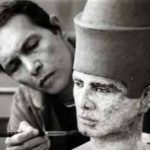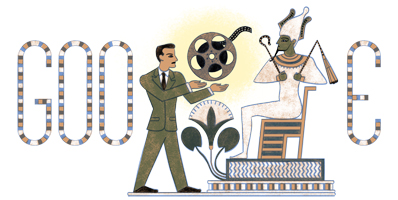Shadi Abdel-Salam: (1930 – 1986) Posted by Fisal on Mar 18, 2015 in Arabic Language, Culture, Pronunciation, Vocabulary
Ahlan Arabic lovers! Last Sunday, Google showed a picture inspired by the pharaonic civilization showing a Pharaoh فــرعــون sitting on his throne عــرش with the crown تــاج on his head and the Lotus flower (symbol of life and eternity) under the throne. In front of the pharaoh but in a lower level, a person was standing, wearing a European costume and carrying a cinema film stock in his hands as if he was giving it as a present to the Pharaoh. The image symbolizes what this person has contributed to the pharaonic history and civilization.
This person in the European costume was the great and distinguished Egyptian artist and internationally acclaimed filmmaker Shadi Abdel-Salam شــادى عــبــد الــســلام . He was a highly creative designer مــصــمــم ديــكـــور of a set of collections and costumes as well as a screenwriter كــاتــب ســيــنــاريــو and director مــخــرج . His work reflects a unique vision of the ancient Egyptian culture as well as the Islamic and Coptic heritage.
His Early Life and Education
Shadi was born to a rich family in Alexandria on the 15th. March 1930. He graduated from Victoria College كــلــيــة فــيــكــتــوريــا in 1948, travelled to London to study theater الــمــســرح and came back to Egypt in 1950. His family moved to Cairo and he joined the College of Fine Arts كــلــيــة الــفــنــون الــجــمــيــلــة . He graduated in 1955. He studied architecture فــن الــعــمــارة under the well-known Alexandrian architect Hassan Fathy حــســن فــتــحــى and knew about the Islamic architecture from him.
His Artistic Career
Shadi started his career as a designer and worked as an assistant to the artistic designer Ramses Wasif in 1957. Shadi designed the decorations and costumes of some of the most famous historical Egyptian films among which are: Wa Islamah وا إســلامــاه and Al-Nasser Salah Ad-din الــنــاصــر صــلاح الــديــن . He then worked as a historical consultant and supervisor of decoration, costumes and accessories of the Polish film “Pharaoh الــفــرعــون” that was directed by Kavelorovitch كــافــلــيــروفــيــتــش .
https://www.youtube.com/watch?v=hQncgwiPd8A
https://www.youtube.com/watch?v=tNjrfXOgZkM
After that, he worked as a co-director of the film Wa Islamah وا إســلامــاه that was directed by the Italian Andrew Marton آنــدرو مــارتــون . The film was released in 1962. Also, he designed the Pharaoh’s death scene in the Italian film “Man’s Struggle for Survival” that was directed by Roberto Rossellini روبــرتــو روســيــلــيــني and co-directed the American film “Cleopatra” with the American Joseph Mankiewicz جــوزيــف مــانــكــوفــيـتــش . Thus, he established an international reputation.
https://www.youtube.com/watch?v=tNjrfXOgZkM
His Films
- “The Mummy الــمــومــيــاء” or “Al-Mumiaa .. The Night of Counting the Years”, 1968 – 1969 is Shadi Abdel-Salam’s most famous masterpiece. He wrote the scenario of the film in Fus’ha (Modern Standard Arabic) which was uncommon for the Egyptian cinema at the time. He also was the director. The film deals with the problem os stealing and smuggling the ancient Egyptian antiquities, especially the mummies. Shadi received many awards for this film. The film was among the 100 best Egyptian films and was honored in so many festivals in the Arab and foreign world.
- “The Eloquent Peasant الــفــلاح الــفــصــيــح“, 1970 is a charming film that was taken from the ancient Egyptian literature found on papyrus. Shadi wrote the script in Fus’ha and was also the director.
- “Horizons or Afaq آفــاق“, 1973 is a documentary film that reflects the cultural life in modern Egypt. Like most of Shadi’s films, the film almost lacks dialogue. Shadi liked to depend on the camera and images leaving the dialogue to the imagination of the viewer.
- “Armies of the Sun or Goyoush Al Shams جــيــوش الــشــمــس” produced in 1975, this documentary tries to express the happiness and joy of the Egyptian soldiers following the 1973 October victory over Israel.
- “The Tragedy of the Great House مــأســاة الــبــيــت الــعــظــيــم” or “Akhenaten أخــنــاتــون” as it is also known, was to be a historical epic on the reign of the Pharaoh Akhenaton. However, the film was not completed before Abdel-Salam’s death, owing to his insistence on Egyptian funding; he repeatedly rejected offers from foreign sources (including several generous ones from French backers), insisting that a film on Egyptian history be made exclusively with Egyptian money. Abdel-Salam worked on this project for 10 years during which he made 4 rewrites of the script but never decided on a final version of the film and died before completing it, although most of the decorations, scenes, and costumes were finished.
All his life, Shadi Abde-Salam was in a continuous search for the absent history and identity. He loved the ancient Egyptian history so much that he wanted to employ it in reactivating the people. Abdel-Salam died in October, 1986.
*****
Check us back soon
Peace ســَــلام /Salam/

Build vocabulary, practice pronunciation, and more with Transparent Language Online. Available anytime, anywhere, on any device.
About the Author: Fisal
Well, I was born near the city of Rasheed or Rosetta, Egypt. Yes, the city where the Rosetta Stone was discovered. It is a small city on the north of Egypt where the Nile meets the Mediterranean. I am a Teacher of EFL.






Comments:
example my ass 2:
If you like reading a blog, what kind of interesting things that make you like that blog? Give me your favorite blog links too..